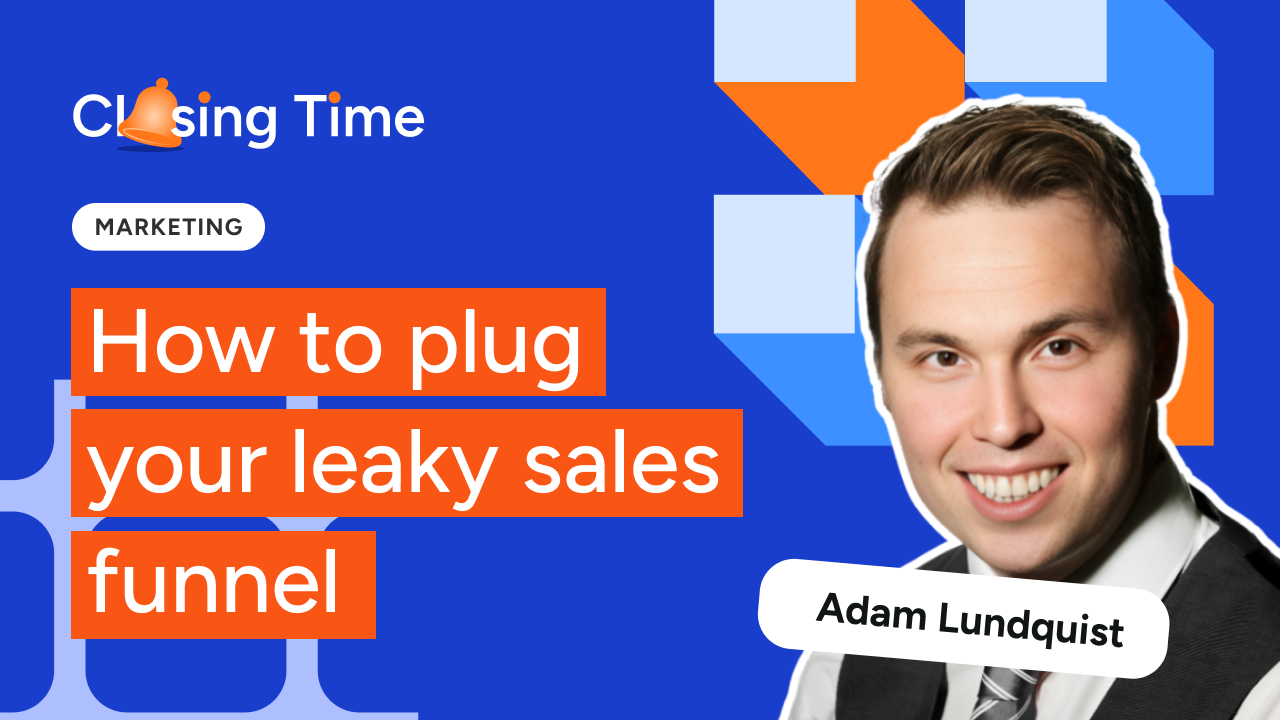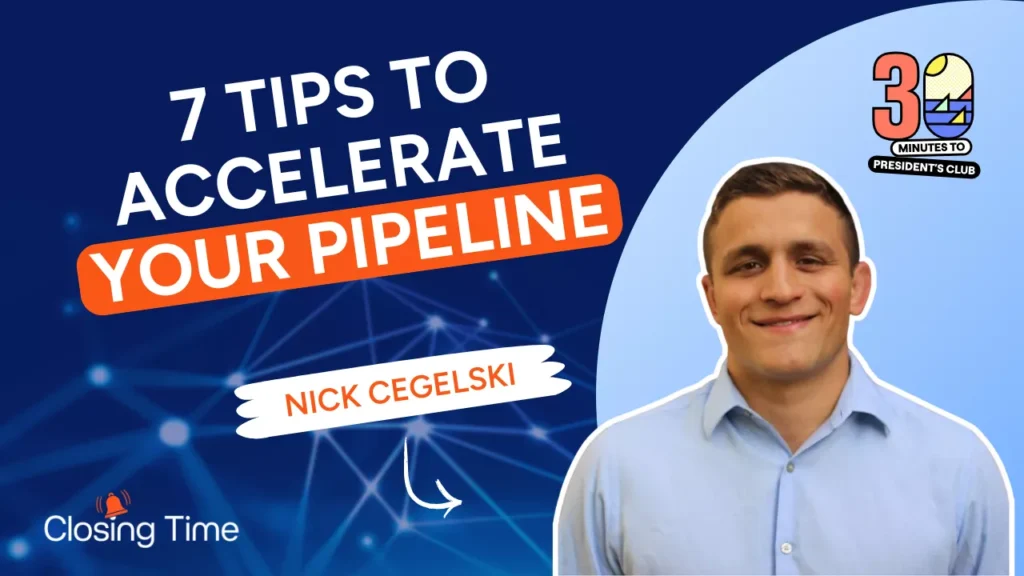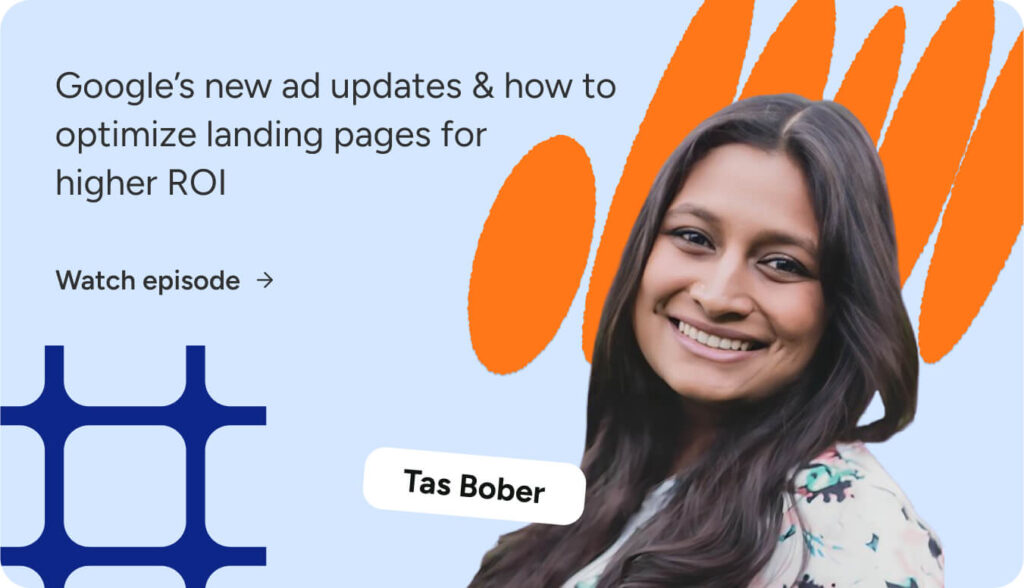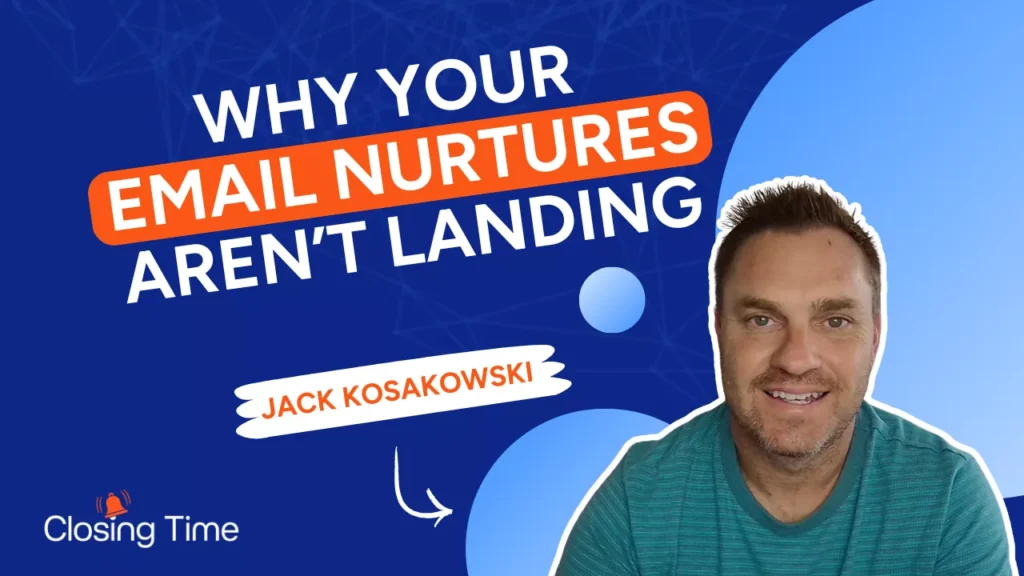When you know exactly where your funnel is leaking, you can fix it fast.
Let’s talk about the lead hand off and how to make it better.
In today’s episode of Closing Time.
Thanks for tuning into Closing Time, the show for Go to Market Leaders.
I’m Val Riley, head of marketing for Unbounce, Insightly, and LeadsRx.
Today I am joined by Adam Lundquist.
He is founder of Nerds. Do It Better, a marketing firm.
Adam, so glad to have you on the show.
Yeah.
Thanks for having me.
I hope this is a super helpful episode.
I think it’s going to be because you give some real tactical tips,
so let’s get right into it.
You’ve used Unbounce for quite some time.
And so, you know, the landing page space really, really well.
A lot of what people focus on with landing pages has to do with conversion
rate optimization.
But you contend that the steps after that tend to be where the leaks happen.
Can you tell us why?
Yeah, absolutely.
And it’s something. I’m really passionate about.
For a long time, the industries that I work in, marketing.
We’ve all been obsessed with optimizing for clicks and conversion rates,
getting people to fill out the form, take that first step.
But right now, what I’ve seen, that’s kind of table
stakes, both for my own agency and the companies we work off.
Because the real drop off is happening after the conversion,
and a lot of businesses put so much effort into generating leads.
But when someone fills out a form, there’s often a gap,
a lack of follow up, a slow response time, unclear next steps.
In fact, studies show that 20 to 50% of leads
never actually connect with the business after converting.
And that is a huge leak in the funnel.
And it’s not because the landing page didn’t work,
but because the follow up process wasn’t optimized.
And the reality is, if you don’t connect with the lead
clearly quickly, you risk losing them entirely.
They might go to a competitor, they might lose interest in your service.
So while conversion is important, the steps that come after
how fast you follow up, how easy make them for take the next step
and reinforce the decision is just critical.
This is where a lot of revenue is lost right now, and that’s why I
and my company focus so much on optimizing the post conversion experience.
Adam, I have to tell you, that statistic literally breaks my heart as a marketer
because there’s part of me that thinks, okay, I’m in marketing.
And once we generate the lead,. I just want to pass it over the fence and,
and and move it into the next phase and pass that to another team.
But the truth is, we as marketers can’t do that.
We have to make sure that the pass happens exactly the way we want it.
And I love these tips
that you’re going to give folks because I really feel like it.
It definitely, connects the dots.
So I’d like to break down how companies can make sure
that post form fill experience is perfect.
So one thing you say is, communicating
form fill success to a user is pivotal.
And this sounds easy, but a lot of people do a lot of work to mess that up.
Yeah, you’re right, it does sound simple, but it’s one of the most common places
that companies drop the ball.
And one of the cool things about Unbounce
is that you can actually split test your confirmation page.
So after someone fills out a form, that’s the moment
when they’re most engaged and interested in your business.
So I kind of align this to Google’s old value proposition, as they knew
with 100% accuracy that if you type something in,
they had your full, undivided attention on the results page.
So almost think of it as a results page.
But too often companies just show a generic
thank you message, or worse, nothing at all.
Sometimes the form doesn’t even disappear, so the user isn’t even sure it worked.
And this creates uncertainty and frustration.
The users are left wondering, did my message go through?
Who’s going to contact me?. What happens next?
And that’s a missed opportunity to build trust and momentum.
So instead you want to give clear, immediate feedback.
Let them know one that the submission was successful
and two, what the next steps are, what they can expect from you.
So for example, instead of just saying, hey, thanks, we’ll be in touch,
you could say something like, hey, thanks for reaching out.
A member of our team will contact you within the next 24 hours.
In the meantime, here’s what you can expect.
You can even say, hey, they’ll be contacting you from this phone number.
That could be a real big one.
It’s about reducing friction and anxiety, making the user feel confident
that they’re in good hands.
This small change can make a big difference
in whether the lead stays engaged, or whether they drop off.
I really feel like matching the urgency of the user is vital here,
because you’re right, some people are in research mode
and they might work for a very slow moving organization.
And or maybe it’s something
they’re purchasing for themselves, but they don’t have a tight timeline.
And that’s okay.
But if someone has urgency, meeting them, meeting that urgency with your own
urgency can really make a difference in, in moving the deal forward.
Yeah, matching an urgency with the user.
It’s critical and it’s one of the biggest factors.
And whether a lead is a conversion
and just like a cool stat that you put on your refrigerator
or they actually become a prospect who’s in your funnel or a sale.
So when someone fills out a form, that’s the peak of their interest.
And if you wait too long to respond, then momentum fades fast.
I’ve heard this kind of described as a half life of a lead,
which I like that idea.
You know, if you contact the lead immediately, they’re much more interested.
Whereas if you contact them two,
three days later, honestly, they’re going to forget.
And the data backs this up.
Companies that respond within five minutes are eight times
more likely to convert a lead,
but most businesses are much slower, sometimes taking hours days.
And there’s a couple ways to really, really make this easier for you
and to make it a better user experience.
One you can automate immediate responses.
Use tools like Unbounce, obviously.
Zapier.
I’m a huge fan of in your CRM, something like Insightly
to trigger instant personalized emails as soon as the form is submitted.
And this shows your lead that you were expecting them
and that you value their time because it’s a pretty dicey moment.
Like no one really wants to hop on a sales call.
So the next thing is to set clear expectations and really sell it on the
thank you page.
That confirmation page let the user know exactly what to hear from you,
whether it’s a call within an hour or if you do have to take a day,
let them know it’s going to be a day.
You can also offer instant next steps.
I’ve been seeing this quite a bit lately and I think this is absolutely amazing.
You could do things like
have a button that opens a WhatsApp chat, opens in immediate zoom.
You can have one that has an instant call connection.
You can have a calendly there to book that next step in.
But it’s about meeting the user where they are
because they’re most engaged, the most interested.
And the faster, the clearer and more benefit focused your follow up
is, the more likely turn that lead into a real opportunity.
I would like to echo the calendly option.
It’s one thing that we’ve put in place here at in our organization
and have seen I have been in surprised at how many people take that option.
So on the thank you page, the Unbounce thank you page, we say, okay,
we’ve received your information.. We’re going to reach out.
But here’s a calendly if you would like to go ahead and schedule a time right now.
And what’s amazing is that we’re able to in Insightly CRM,
pause the sync of the lead so that if the person does select
that calendly, we don’t end up with with duplicate entries.
But if they don’t select the Calendly, then we process them as a regular lead.
But I’ve really been surprised at the uptake on that calendly.
People, like you’re saying,
they’re engaged at that moment and they want to act,
and we’re giving them the opportunity to act.
Yeah, one cool hack you can actually do on Unbounce,
which I really like, are the top bars, the banner bars.
You can have something
says like book and instant Meeting, and that can go right to a calendly page.
I mean, I’m a huge Unbounce fan, but that’s just one way.
It’s not like I’m obsessed with Calendly.
You can do whatever booking system you want,
but the premise is that, hey, they don’t want to fill out a form
and wait, get an instant booking, get an instant meeting.
Those kind of things make a huge difference. Exactly.
Wanted to dig in a little bit on that automated email.
So this is very typical that we see where a company will,
you’ll fill out a form and then you’ll get an automated email.
And typically that automated email is fairly generic.
But you have an idea of how to make that email
super personalized with using just a few tools.
Can you talk us through that? Yeah, absolutely.
Sending an automated email right after form, it’s a great start.
But personalization and again, like if you’re not even sending out an email
then that’s an awesome start.
But personalization is what really makes your follow up stand out and feel genuine.
Most companies send a generic thank you email, and it doesn’t make
the lead seem valued or seen.
So instead, you can use the information the user provided in your advanced form
to craft a message that speaks directly to their needs and goals.
For example, I did a webinar with with you guys actually,
we shared how you use tools like Unbounce, Zapier, and ChatGPT
to create a personalized email.
So the basic gist of it is when someone fills out a form,
we pull in the form details like their name, their company,
what they’re looking to achieve, if that’s one of your form details.
And then we push those into the next step in Zapier,
we say, hey, create an email using this kind of format where we say,
you might say, hey,. I want it to be about this specific goal.
So you have chat do that.
You 100% want to test this out quite a few times,
but then when you do that, this approach makes the lead feel
like you understand the situation and that you’re ready to help them out.
Specifically, it’s a more person to person,
even though it’s
ChatGPT mediated, it’s very person to person feeling.
So it’s almost how email should feel 1 to 1 rather than a big old generic hey,
thank you for filling this out.
It might say, hey, thank you for filling out the form.
You know, it says that you’re looking at this kind of services.
These are the kind of things we do.
And you could even have it do things like using Zapier in chat.
You can have it.
We search people on LinkedIn.
You can have it do all sorts of stuff, and you have to find that
Goldilocks area where it’s personalized but not creepy.
But what I found is people really, really enjoy that.
And if you’re in any sort of SaaS tech company, it shows that you’re tech savvy.
Yeah.
Making people feel seen, heard and understood at that pivotal point
where they are completing a form and asking to talk to you.
That’s got to be a huge win.
It is a huge win, and it really makes a huge difference.
another automation you can run is, a message,
a message service, as long as you’re SMS compliant,
you know, you can basically just put in their name.
You can in the future.
I do so very little bit,
but you can also have an actual chat bot chat with people via SMS.
There’s quite a few different ways, and obviously the world is changing
quickly and that’s where you want to be, is you don’t want to be stuck in the 80s.
You want to be in a whatever.
And now the 20s, using AI,
using these things to personalize and have that one to many connection.
So one other idea you shared is potentially
creating a LinkedIn connection based on a form fill.
I’d love to you to talk us through that one.
Yeah.
So you can use a tool like Zapier, as well.
And honestly, I just say Zapier, but. I’m sure you could do it in maker pebbly.
I think it’s called or whatever it is,
but the basic gist of it is that you take a business email,
and when that comes in, you have the link to an automatic connection.
You want to be real careful with this, because if you have too many connections
that get denied, I think you get like a LinkedIn ban of some sort.
But if you’re just like a local business, there’s no reason not to do this.
You know, you’re not going to get a bazillion leads.
You might get whatever, ten, 15 a day.
Why not do that?
That’s a great way to meet your customers where they want.
This is something. I’m really kind of passionate about is
when I started doing marketing, man, that was a long time.
Like ten years ago.
Even a little more email.
Was it like you send people an email?. You got it.
But I think we’re on the other end of it.
We get a million emails a day.
So I actually prefer in my real life, in my business life to use, messages
like WhatsApp.
So if LinkedIn is where your people are and that’s how
they want to communicate, why not meet them where they’re at?
If you’re the business that meets them where they’re at,
you can do a million times better than the business who doesn’t?
And that’s kind of true with it’s becoming more and more true with phone
calls, too, as we’re seeing like people want to get that call less and less,
and they’d much rather just text or, message or whatever it may be.
An the same thing is true, with Facebook, when you actually reach out to them
via Facebook,
that’s a good way to reach out if that’s where your customer’s prospects are.
So you’ve presented a lot of ideas here.
Some of them are easy to implement and some might require some automation.
But I think the potential value is huge.
So just to reiterate that connection rate versus the conversion rate,
what really if you optimize for your connection
rate, what types of results do you see for businesses?
Yeah, the connection rate is absolutely critical and it’s overlooked.
And I did give you some pretty techie ideas,
but honestly, if you hit something like instead of having a thank you
message on your, confirmation page, you sold it.
You could split test and Unbounce quite easily and just follow the numbers.
But it’s absolutely critical because it’s the bridge between generating leads
and closing leads.
So like an idea versus getting business,
you can have the best landing pages, the highest conversion rates.
But if you’re not connecting with the leads,
meaning actually having the real conversation,
you’re leaving a huge amount of revenue on the table.
And the numbers are staggering.
When I was, prepping for this,. I found a couple of stats.
But businesses lose up to $1 trillion due to poor lead follow up.
Not one business businesses overall,
and nearly 58% of initial inquiries never receive a single follow up.
Val, that’s crazy.
That’s like that is wild to me.
And this means that all the money
and effort spent on driving traffic and getting form fails is wasted.
If you don’t take that next step to connect.
Connection rate is where the real business happens.
It’s not enough to just get someone to raise their hand.
You need to engage with them quickly.
Make it easy for them to take the next step
and reassure them that they’re in good hands.
And when you optimize for connection rate, you’re not just improving a metric,
an online metric.
You’re directly impacting your bottom line by turning more leads
into real opportunities and ultimately, customers.
That’s why I always say don’t stop at the conversion.
The real one is the connection.
I say don’t stop at the click.
But as we’ve progressed on, don’t just stop at the conversion.
Adam, thank you so much for providing so many actionable tips here.
I know our audience is going to love it.
Where can folks go
if they want to learn more about you, your firm, and your services?
Yeah, thanks so much for having me.
If anyone wants to learn more about
We do and nerds do it better, you can go to nerdsdoitbetter.com.
If you’re interested in coaching, consulting,
actually, having us run this for you,
you can just check out nerdsdoitbetter.com.
You can also connect with me directly on LinkedIn.
Just search for Adam Lundquist.
I’m always happy to chat, answer questions, or share more about how
we help businesses turn more leads into real conversions and close deals.
And, thanks again for the opportunity to share these cool strategies.
Thank you.
And and you definitely are in contention for the best company
name of a guest we’ve had on this the podcast.
So I love the name, love the firm, and. I love what you’re doing with Unbounce.
Well, thanks for having me, Val.
And thanks so much to all of you for tuning in to Closing Time.
Remember, you can get this episode delivered right to your inbox.
Just click the link in the show notes and we’ll see you next week.




